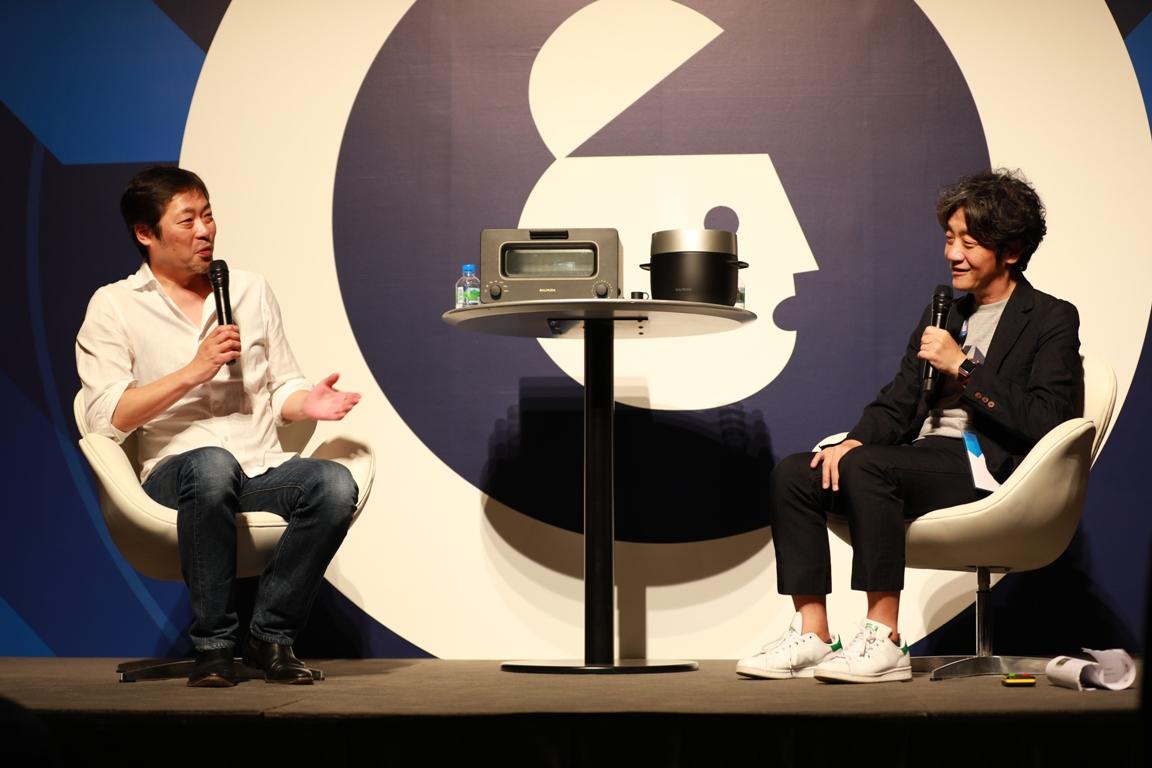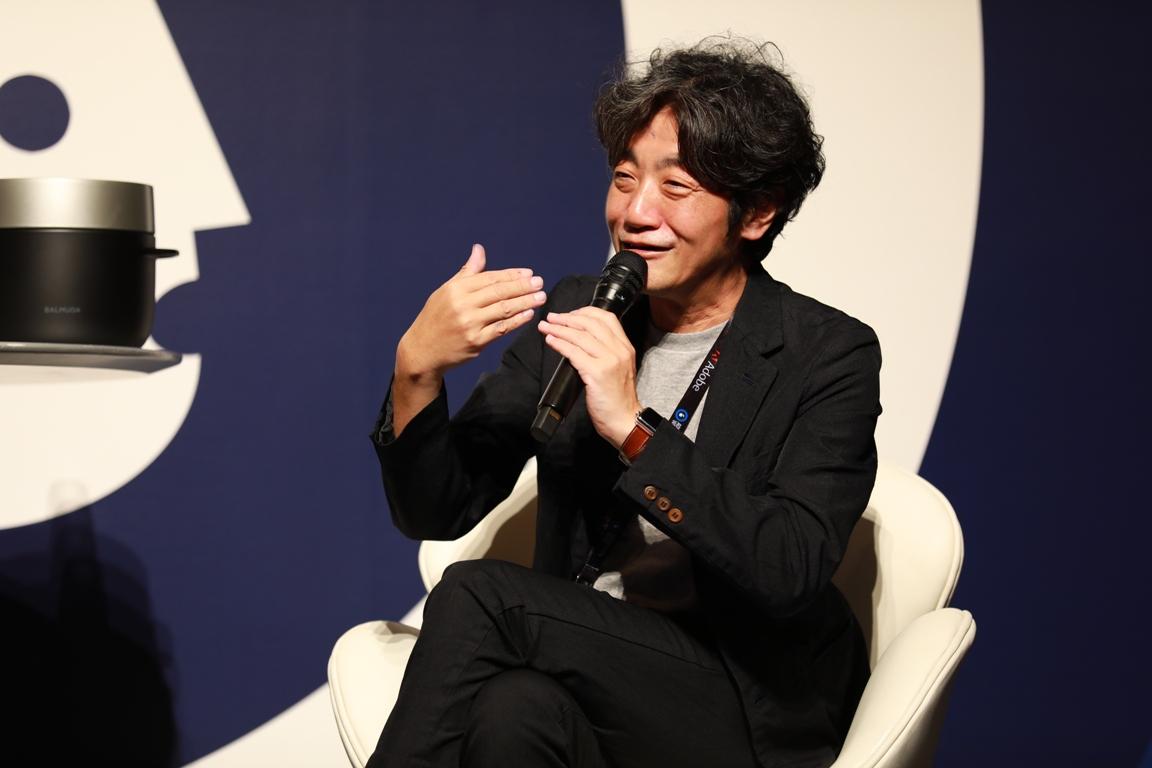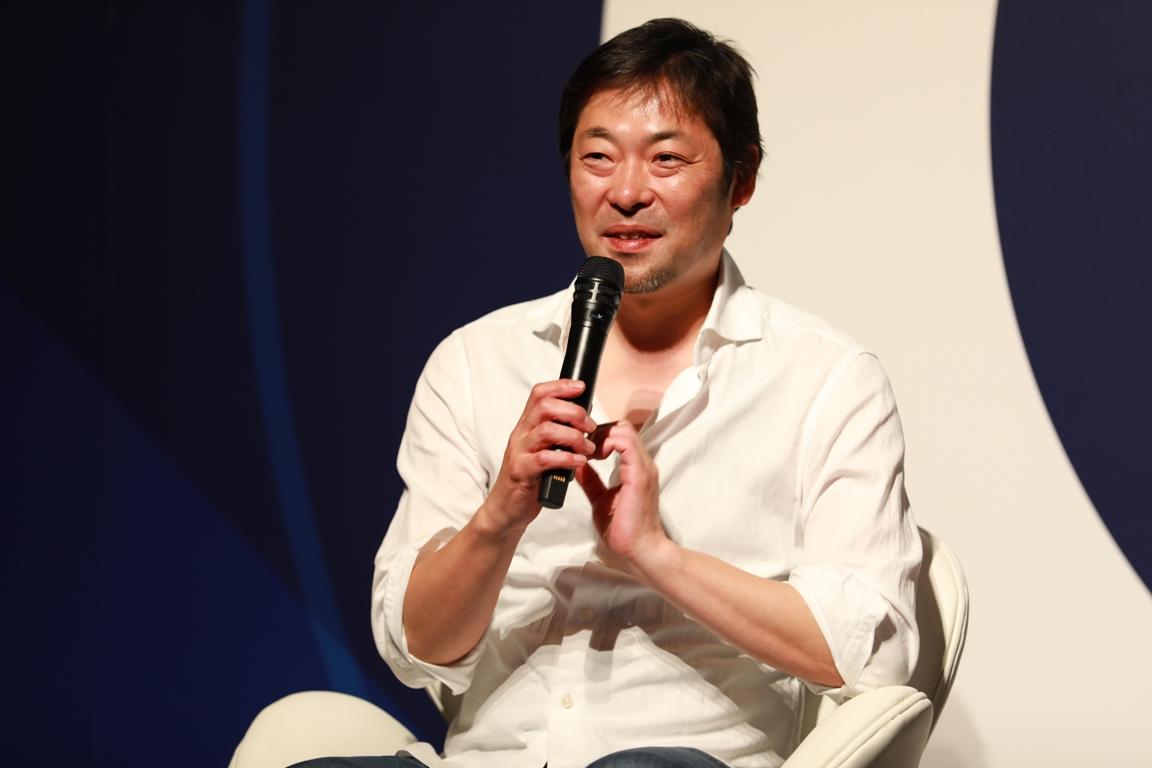- Viewpoints
- Events
The second Advertising Week Asia took place May 29-June 1, 2017, at Roppongi Midtown in Tokyo. This year’s event again brought together leading figures in the fields of advertising, marketing, and technology from all over the world to discuss hot topics like mobile marketing and the future of artificial intelligence.
One session featured Koichiro Shima of Hakuhodo Kettle in conversation with Gen Terao, CEO of Balmuda, developer of the toaster that makes the perfect toast. Terao explained how the toaster came into being and what inspires Balmuda to create such strikingly innovative products.

A groundbreaking product needs to resonate with people.
SHIMA: Good afternoon. I am Koichiro Shima of Hakuhodo Kettle. Our guest for this session is Gen Terao, CEO of Balmuda Inc. Balmuda manufactures home appliances that are truly groundbreaking, such as a fan that generates a natural airflow with a double set of blades, and a toaster that makes wonderfully delicious toast. I own one of these toasters myself, and I just love it. It really does a great job of toasting your bread. When you toast croissants in it, they come out crisp on the outside and soft and springy on the inside–the best of both worlds.
What I find amazing about you, Terao-san, is the way you’ve revolutionized home appliances with new ideas and designs when everyone thought they couldn’t be improved on any further, and thus brought innovation to the commodities market. And the way you deliver a new experience to users like nothing they’ve known before. Today I’d like to start by asking you what lies behind your innovations in home appliance technology. You were in fact originally a musician, right?

TERAO: That’s right. I dropped out of high school when I was seventeen and spent a year wandering around Europe and elsewhere on my own. When my travels were over and I got back to Japan at eighteen, I thought I could become anything. So throughout my twenties I seriously pursued my dreams of becoming a rock star, which didn’t however pan out in the end [laughs]. But ever since that time I’ve had a desire to transform the creativity that’s seething inside me into some form in which I can share it with others. And when I do share it with others, they say, “I get it!” “I feel the same way!” It’s a wonderful feeling to be told that. No song or product ever becomes a hit without resonating with people like that. In my case I failed to win empathy with my music, but now I hope to strike a chord with others through our home appliances.
SHIMA: It must be as difficult to strike a chord with people through home appliances as through music.
TERAO: It is. The fact is that most manufacturers of home appliances only ever talk about technology and consider striking a chord with people of secondary importance. True, there was a time when people were after convenience as measured in numbers, but now that almost every household has all the appliances it needs, competing over specs isn’t going to get you very far. I think what people really want today is not technology but art. What can’t be measured in numbers–the beauty of something or how good it tastes or feels–is more important to them. That conviction made me want to design something like nothing before, something that would strike a chord with people.

A desire to make wonderfully delicious toast
SHIMA: This toaster has been a tremendous success. Why did you decide to make it?
TERAO: Because eating toast each morning, I became convinced that there must be a way to make better-toasting toast.
During my solo travels at age seventeen, I once arrived in a town in Spain physically and mentally exhausted, when I noticed a wonderful aroma emanating from a nearby bakery. I was famished. I bought some bread and ate it, and for some reason the tears welled up in my eyes and wouldn’t stop. Never in my life had bread tasted so good. One thing I realized at that moment was that food doesn’t disappear when you eat it; it enters your body to become the energy that keeps you alive. That’s the power of food. That’s what it means to live.
It then occurred to me that if your daily bread tasted a bit better, you might have more zest for life. So that’s what motivated me to design this toaster.
SHIMA: “Better-tasting toast” is pretty abstract. How did you convey that to your engineers?
TERAO: At first I could only give them a rough idea: what I want to eat is wonderfully delicious toast. Then investigations began into the mathematics of wonderfully delicious toast. For example, bread and toast differ in both color and weight. When you heat bread, the starch gelatinizes at 50-60˚C. Gelatinization makes the bread soft and fluffy. Starch originally contains water, but it loses moisture over time and hardens compared to bread in its freshly made state. Gelatinization is the process of restoring moisture. The longer spent on that step the better. The phenomenon whereby the surface of the bread turns golden-brown is termed the Maillard reaction, which begins at 160˚C. Carbonization then begins at 220˚C. When the Maillard reaction occurs, the number of chemical substances on the surface of the bread increase from several dozen to well over a hundred. Many compounds are produced that, say, have an almond-like aroma or are sweet like chocolate. They’re the reason food tastes good when its cooked. The Maillard reaction makes the surface fragrant and crispy, gelatinization keeps the inside moist and rich, and the whole is piping hot throughout. That’s the reason toast or steak or octopus balls taste so good when they’re cooked.
SHIMA: Right. Incredible [laughs]. So that’s how what you call “wonderfully delicious toast” can be described once your technical people have scientifically analyzed it. All you needed to do now was design a toaster that caused that to happen.
TERAO: But just because you understand the principle, that doesn’t mean you can instantly put it into practice. We hit on the idea of using steam by sheer coincidence.
We were still working on the toaster, and we planned to have a barbecue near the office one day. When the day came, it was pouring with rain, but we decided to go ahead with the barbecue anyway because we thought it would make a great memory. We toasted some bread over a charcoal fire, and it tasted absolutely delicious: crispy on the outside, soft and springy on the inside. That gave us a clear target: what we were aiming to make was toast like that. But we just couldn’t recreate the toast we had eaten on that day with charcoal alone. Only several days later, when one of our people pointed out that it had been pouring with rain that day, did we realize that to make great toast you needed steam.
SHIMA: When you heat bread in BALMUDA The Toaster, you pour 5 cc of water into the water slot, right?
TERAO: That’s right. That 5 cc of water is heated in the boiler and all evaporates, depositing a fine film of moisture on the surface of the bread. The heating control then kicks in. Water heats much more quickly in its liquid state than in its vaporous state, making it possible to lightly toast just the surface of the bread first. Then the bread is warmed as in a regular toaster, but because the surface is already baked hard and the chamber is full of steam, no moisture escapes from inside the bread. So the bread remains deliciously moist and rich on the inside while being crispy on the outside.
The best experiences involve all five senses.
SHIMA: Balmuda’s approach to manufacturing is rooted in the idea of sharing what you yourselves like with greater numbers of people, right?
TERAO: That’s right. We don’t conduct market research or do marketing. If we make what we think is a great product and it turns out to be failure, that we can accept. But if we made what someone else thought was a great product and it turned out to be failure, then all we’d have to show for it would be bitter feelings. So it’s better if from the start we make what we think is great.
SHIMA: What did you concentrate on most in terms of design?
TERAO: We really agonized over the design. In our previous products we’d aimed for a sharp-looking, simple design, but if you design a toaster on that principle, it ends up looking just like a printer [laughs]. So we changed tack and decided to ask ourselves what part of the toaster the toast would look the most delicious coming out of when done. In the end the design team and I agreed it should look something like the oven in the animated movie Kiki’s Delivery Service in which grandma cooks herring pie.
SHIMA: Right. One thing that I find with the Balmuda toaster is that it’s a pleasure to use, what with the satisfying sound of the timer and the way the heating elements light up so beautifully. A lot of thought must have gone into that too.
TERAO: The act of eating involves all of a person’s five senses: sight, hearing, smell, touch, and taste. The taste, I therefore believe, is also affected by the design, the sound of timer, and the way the heating elements light up. So we went through lots of trial and error to optimize the quality as perceived by all five senses. We made over 5,000 pieces of toast during development [laughs].

A rice cooker that makes your whole meal taste better
SHIMA: Your latest creation is a rice cooker called BALMUDA The Gohan. Why a rice cooker after a toaster?
TERAO: I’m Japanese, so rice seemed the obvious follow-up to bread. Our aim during the development process was to come up with a rice cooker capable of making a bowl of rice that didn’t just taste good in isolation but was delicious as part of a meal–that made your meal taste better in the sense that it acted as a foil to the main dish.
Your typical rice cooker electrically heats a cooking bowl containing rice and water, but this device has two cooking bowls, an inner bowl in which you put rice and water, and an outer bowl in which you put just water. Only the outer bowl is heated. The water is all converted to steam, and the rice is cooked by steam alone. Because the rice remains almost motionless during cooking, all its energy is still locked inside when it’s done. So it’s firm, lustrous, and deliciously chewy.
SHIMA: I’ve given it a try. I was amazed how good it tastes even cold. It’s wonderfully delicious cold with a raw egg on top.
TERAO: It sure is. Why I don’t know, but even cold it tastes incredibly good. When you eat it, the individual grains are wrapped in the succulent fat from the other ingredients, without actually absorbing it, and convey it into your mouth to savor. That’s what I consider to be the perfect rice, and that’s what we figured out how to make.
Delivering better experiences to all
SHIMA: What do you at Balmuda plan to do next?
TERAO: I dedicate my life to this company with the goal of striking a chord with as many people as possible. Fortunately our vision of delivering not just a product but an experience has won acceptance among the public, and business is going well, so this year we’ll be rolling out a new offering for the kitchen. We’re also working on products in the air conditioning and environment fields.
SHIMA: Thanks for your wonderful insights today.














